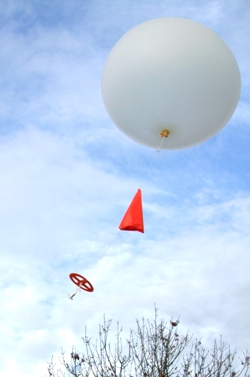'Light meter in the sky' opens a window into the secret world of clouds
Release Date 02 March 2012

On a foggy spring morning, as experienced in parts of the UK over the past few days, looking to the horizon, it can be difficult to tell where the land ends and the sky begins. Now scientists at the University of Reading have found a new way to see inside and above clouds.
Atmospheric scientists from Reading's Department of Meteorology have designed a sunlight-measuring instrument that uses the natural swinging and spinning motion of a rising weather balloon to distinguish clouds from clear air. The device, described in a paper published in the American Institute of Physics' journal Review of Scientific Instruments, may provide higher-resolution measurements of clouds than is currently possible, particularly for thin clouds - which could help meteorologists provide more accurate weather forecasts.
Anyone who has looked out of an aircraft window when in cloud - or anyone in the fog in South East England over the past couple of days - will have noticed that things look equally dull in all directions. Outside cloud or fog, however, the sun can dazzle depending on which way we look.
The team from the University of Reading exploited this by realising that, in the bland conditions inside a cloud, there would be less variation in sunlight compared with clear air conditions. They reasoned that, by simply comparing measured fluctuations in cloud and clear air, cloud could be sensed optically using a routine daytime weather balloon carrying their device.
Laboratory experiments demonstrated that the new airborne light meter worked consistently over the range of temperatures weather balloons encounter.
In test balloon flights, the optical technique did indeed report much smaller optical fluctuations within cloud as suspected, locating upper cloud boundaries with good precision, which they compared with the traditional measurement of temperature and relative humidity. The researchers add that the new system could also be used to determine lower boundaries of clouds in broken cloud conditions.
Dr Keri Nicoll, the University of Reading research scientist working on the project, said: "This new idea combines a weather measurement mainstay with simple technology in an innovative way. Knowing reliably where clouds occur is central to providing accurate weather forecasts."
Professor Giles Harrison, Professor of Atmospheric Physics at the University of Reading, said: "Weather balloons have been a long-standing method for gathering data on weather conditions since 1929, but until now we have not been able to use them to visually measure clouds."
Ends
For more details, contact Pete Castle at the University of Reading press office on 0118 378 7391 or p.castle@reading.ac.uk.
Notes to editors:
The paper, Keri A. Nicoll and Giles Harrison, 'Balloon-borne disposable radiometer for cloud detection,' was published in the current issues of the Review of Scientific Instruments. The project was funded by the Natural Environment Research Council (NERC).